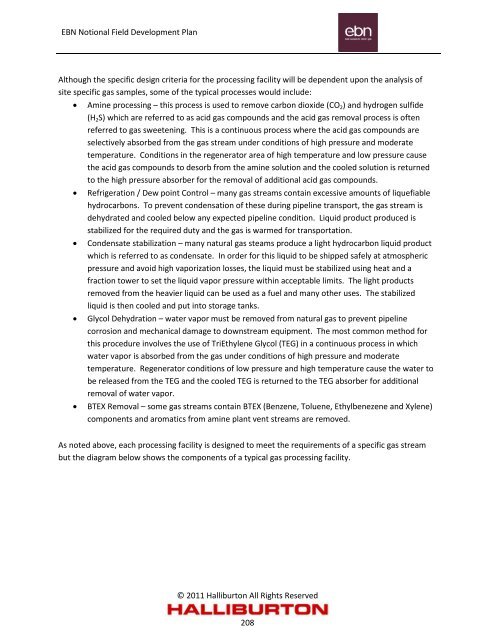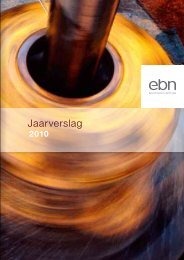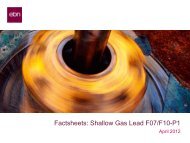Notional Field Development Final Report - EBN
Notional Field Development Final Report - EBN
Notional Field Development Final Report - EBN
Create successful ePaper yourself
Turn your PDF publications into a flip-book with our unique Google optimized e-Paper software.
<strong>EBN</strong> <strong>Notional</strong> <strong>Field</strong> <strong>Development</strong> Plan<br />
Although the specific design criteria for the processing facility will be dependent upon the analysis of<br />
site specific gas samples, some of the typical processes would include:<br />
• Amine processing – this process is used to remove carbon dioxide (CO 2 ) and hydrogen sulfide<br />
(H 2 S) which are referred to as acid gas compounds and the acid gas removal process is often<br />
referred to gas sweetening. This is a continuous process where the acid gas compounds are<br />
selectively absorbed from the gas stream under conditions of high pressure and moderate<br />
temperature. Conditions in the regenerator area of high temperature and low pressure cause<br />
the acid gas compounds to desorb from the amine solution and the cooled solution is returned<br />
to the high pressure absorber for the removal of additional acid gas compounds.<br />
• Refrigeration / Dew point Control – many gas streams contain excessive amounts of liquefiable<br />
hydrocarbons. To prevent condensation of these during pipeline transport, the gas stream is<br />
dehydrated and cooled below any expected pipeline condition. Liquid product produced is<br />
stabilized for the required duty and the gas is warmed for transportation.<br />
• Condensate stabilization – many natural gas steams produce a light hydrocarbon liquid product<br />
which is referred to as condensate. In order for this liquid to be shipped safely at atmospheric<br />
pressure and avoid high vaporization losses, the liquid must be stabilized using heat and a<br />
fraction tower to set the liquid vapor pressure within acceptable limits. The light products<br />
removed from the heavier liquid can be used as a fuel and many other uses. The stabilized<br />
liquid is then cooled and put into storage tanks.<br />
• Glycol Dehydration – water vapor must be removed from natural gas to prevent pipeline<br />
corrosion and mechanical damage to downstream equipment. The most common method for<br />
this procedure involves the use of TriEthylene Glycol (TEG) in a continuous process in which<br />
water vapor is absorbed from the gas under conditions of high pressure and moderate<br />
temperature. Regenerator conditions of low pressure and high temperature cause the water to<br />
be released from the TEG and the cooled TEG is returned to the TEG absorber for additional<br />
removal of water vapor.<br />
• BTEX Removal – some gas streams contain BTEX (Benzene, Toluene, Ethylbenezene and Xylene)<br />
components and aromatics from amine plant vent streams are removed.<br />
As noted above, each processing facility is designed to meet the requirements of a specific gas stream<br />
but the diagram below shows the components of a typical gas processing facility.<br />
© 2011 Halliburton All Rights Reserved<br />
208







